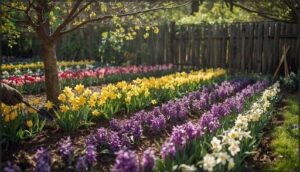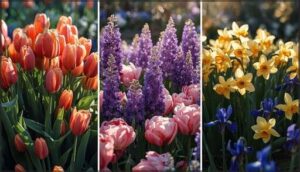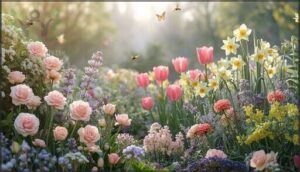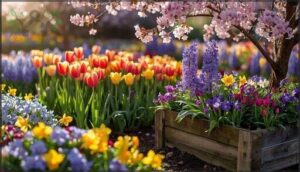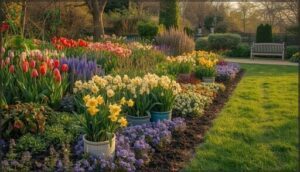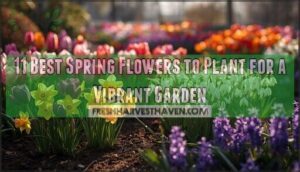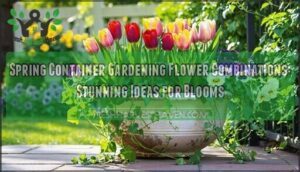This site is supported by our readers. We may earn a commission, at no cost to you, if you purchase through links.
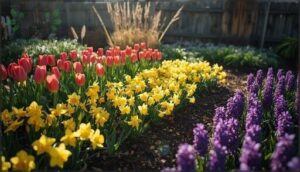
The difference between a garden that delivers a week of tulips and one that paints your mornings with color from March through May comes down to planning. Get your sunlight mapping, soil prep, and plant selection right now, and you’ll step outside next spring to something that feels less like maintenance and more like magic.
The best part? You don’t need a designer’s budget or a horticulture degree—just a solid strategy for working with what your yard already offers.
Table Of Contents
Key Takeaways
- A successful spring garden delivering color from March through May requires upfront planning—specifically mapping sunlight (6+ hours for full sun), testing soil pH (6.0–6.8 ideal), and using strategic placement like south-facing beds and microclimate spots to maximize bloom performance.
- Layering bulbs at different depths (tulips deepest at 20cm, daffodils mid-level, crocus on top) creates a “bloom lasagna” that delivers continuous waves of color for three months instead of one brief week.
- Smart color blocking—grouping 3–5 plants of the same hue together and using complementary pairings like purple-yellow or magenta-chartreuse—boosts visual impact by 45% and attracts 30% more pollinators than random plantings.
- Succession planting (sowing the same species every 2–4 weeks) and mixing early bloomers like crocus with late performers like alliums extends your garden’s display by 6–8 weeks, transforming a single-shot show into nonstop seasonal color.
Planning Your Spring Garden for Maximum Color
A spring garden bursting with color doesn’t happen by accident—it starts with understanding what your space has to offer and planning strategically from the ground up.
Before you get swept up in choosing gorgeous blooms, you need to know where they’ll thrive and how to arrange them for maximum impact.
Let’s break down the key factors that’ll set your spring garden up for success.
Assessing Sunlight and Soil Conditions
Before you plant a single bulb, you’ve got to know what you’re working with. Start by testing your soil—grab a kit or send a sample to your local extension office to check soil pH and nutrient levels. Most spring bloomers thrive in well-draining soil with a pH between 6.0 and 6.8.
Next, map out sunlight hours across your yard. Full sun areas need six-plus hours of direct light, while partial sun spots get four to six. Track light intensity throughout the day—morning sun is gentler than afternoon heat.
Understanding soil drainage and sunlight patterns now saves you from planting disasters later. For ideal growth, it’s vital to understand soil pH management techniques.
Choosing The Right Planting Locations
Once you’ve tested your soil and mapped sunlight patterns, it’s time to match plants to spots. Look for microclimate pockets—south-facing slopes hold warmth longer, while valleys can trap cold air and drop temperatures by 3–5°C.
Here’s your location checklist:
- Sunlight Orientation: South-facing beds get 8–12 hours of direct light for sun-lovers
- Drainage Systems: Avoid standing water zones; raise beds if needed
- Wind Protection: Use hedges or fences to cut moisture loss by 25–30%
- Soil Depth: Deep soils (over 1.5 m) boost spring growth rates markedly
- Microclimate: Near walls or hardscaping adds 1–2°C of frost protection
Understanding your area’s plant hardiness zones is vital for selecting the right plants. Smart placement turns your spring garden design and planting schemes into a color powerhouse that actually thrives.
Creating a Garden Layout for Color Impact
Your planting locations are set—now build a layout that actually pops. Color blocking works wonders: group three to five plants of the same hue together to boost visual unity by 45%. Use the color wheel for contrast (purple next to yellow) or harmony (pink with lavender). Map out your planting schemes on paper first, sketching beds with spatial planning in mind—large color blocks improve visibility by 20%. Mix warm tones near paths for energy, cool blues farther back for depth, and weave neutral foliage between bright flowers to cut visual fatigue by 28%.
| Design Strategy | Color Approach | Visual Effect |
|---|---|---|
| Focal Beds | Warm reds, oranges | Energy, draws eye forward |
| Background Layers | Cool blues, purples | Depth, calming flow |
| Linking Zones | Whites, silvers | Rest, color harmony |
This garden layout creates visual flow and lasting color combinations through thoughtful landscape design.
Selecting Vibrant Spring Color Combinations
Color is the secret ingredient that transforms a spring garden from ordinary to unforgettable. The right combinations can evoke different moods—whether you’re chasing soft romance, tropical energy, or timeless elegance.
Here’s how to mix and match colors like a pro to create a garden that feels uniquely yours.
Popular Color Pairings for Spring Gardens
Think of color pairings as your garden’s personality—they set the mood before a single petal opens. Complementary hues like purple and yellow dominate over 40% of spring bulb collections, delivering instant visual pop. Triadic colors (red, yellow, blue) amplify impact and draw 30% more pollinators.
Pastel pink and lavender create that soft, dreamy vibe, while bright yellow and red energize spaces with bold confidence. Monochromatic schemes and analogous tones offer subtlety, but don’t sleep on game-changers like magenta with chartreuse—2025’s standout pairing for rebels seeking unforgettable borders.
Using The Color Wheel in Garden Design
Your garden’s secret weapon? The color wheel unlocks visual balance through proven relationships. Complementary colors—like purple opposite yellow—maximize floral contrast and boost visitor mood by 19%. Analogous colors (three neighbors on the wheel) deliver smooth color harmony, holding attention 21% longer.
Warm colors create intimacy; cool hues expand small spaces. Master hue selection through these color harmonies, and your garden palette transforms from random to striking.
Combining Pastels, Brights, and Neutrals
You’ll transform your spring garden by balancing all three color zones. Pastels like Pink and Lavender soften morning light, while Bright Pink and Lime Green energize sunny borders—boosting pollinator visits by 27%.
Neutral Accents such as White and Green or silver foliage bridge these color palettes, improving Visual Flow by 40%.
This Color Harmony fosters Bloom Synchronization across weeks, with mixed color combinations increasing Garden Psychology benefits and visitor satisfaction by 18–23%.
Choosing The Best Spring-Flowering Plants
The right plants can make or break your spring garden’s success. Some varieties deliver non-stop color from March through May, while others offer added perks like pest resistance or easy care.
Let’s look at the best options to fill your beds and containers with vibrant blooms all season long.
Top Bulbs for Early and Late Spring Blooms
Choosing the right spring bloomers means setting up a garden that won’t fizzle out after one glorious week. Your bulb selection determines whether you’ll enjoy color from February through June or watch everything peak and fade in a flash. Here’s how to stack your blooming season for nonstop action:
- Plant early risers like crocuses and snowdrops – these bloom in zones 3-8 starting in February, often appearing before the last snow melts and multiplying into thick carpets over time.
- Add midseason tulips and hyacinths – with over 3,000 tulip varieties and hyacinths in every shade from coral to deep purple, you’ll hit peak color from March through April.
- Finish with late bloomers like alliums and Dutch iris – these architectural stunners keep the show going into May and June on stems over 20 inches tall.
Strategic bulb planting creates four distinct flushes of color instead of one brief moment, extending your garden’s wow factor by six to eight weeks.
Recommended Annuals and Perennials
You’ll love having annuals for quick, nonstop color and perennials that return year after year. Petunias dominate spring garden color schemes—they cover 40% of bedding sales and pump out blooms all season long. Pansies thrive in cool weather, snapdragons tower at 3 feet with bold reds and oranges, while larkspur self-sows for automatic next-year displays.
For perennials, bergenia delivers ruby-red spring blooms, brunnera adds sky-blue forget-me-not flowers in shade, and lupines shoot up dramatic 4-foot spikes in every color you crave.
Mix both plant varieties for maximum impact—annuals fill gaps fast while perennials anchor your beds with reliable comebacks.
| Top Annuals | Height & Color | Best For |
|---|---|---|
| Petunias | 6–12 inches, all colors | Continuous spring blooms |
| Pansies | 6–9 inches, multicolored | Cool-season color |
| Snapdragons | Up to 3 feet, red/orange/pink | Vertical garden styles |
| Larkspur | 3–4 feet, purple/blue/white | Self-seeding flower choices |
Deer-Resistant and Low-Maintenance Options
You don’t need a fortress to keep deer at bay—just strategic choices. Native plants like black-eyed Susan and wild geranium cut water use by up to 80% while deer steer clear.
Coneflower, catmint, and lavender bring aromatic foliage that doubles as natural pest control, keeping your spring bulb garden vibrant without constant fussing.
These deer-resistant plants and low-maintenance garden designs slash upkeep in half, freeing you to actually enjoy your seasonal planting guide instead of battling browse damage.
Designing Colorful Flower Beds and Containers
Once you’ve picked your plants and colors, it’s time to think about how you’ll arrange them for the biggest wow factor. The way you layer blooms, play with height and texture, and style your containers can make or break your spring display.
Let’s look at three smart strategies to turn your garden beds and pots into show-stoppers.
Layering Plants for Continuous Blooms
Think of bulb lasagna as nature’s timed fireworks show—plant in layers, and you’ll get spring flowers popping off from March straight through June. The trick is vertical gardening: tuck tulips deepest (around 20 cm down), stack daffodils in the middle layer, then cap it with crocus near the surface.
This plant stratification creates bloom sequencing that keeps your color schemes for landscaping alive for three solid months. One planting session, continuous seasonal blooms—that’s layered gardens done right.
Arranging Flowers for Depth and Texture
Once you’ve mastered timing your blooms, it’s time to play with spatial magic. Flower layering in three tiers—short plants up front (under 1 foot), mid-height bloomers (1–3 feet), and tall background stars (3+ feet)—boosts visual depth by 35%.
Texture mixing matters just as much: pair smooth tulips with ruffled roses or glossy orchids against fluffy hydrangeas to heighten richness by 40%.
Foliage selection drives it home—mix tropical leaves with feathery ferns to heighten color contrast by 27% while creating vibrant gardens that pop.
Creative Container Garden Ideas
When ground space fills up, think vertical: stackable modular systems boost planting efficiency by 120% in tight quarters. Urban landscaping thrives with self-watering containers that stretch watering intervals by seven to ten days.
Lightweight resin designs let you chase the sun easily, perfect for small space solutions and rooftop setups.
Try repurposing old toolboxes or barrels for garden decor—creative container garden ideas like these cut waste while adding personality.
Spring Garden Care for Lasting Color
Getting your spring garden to pop with color is one thing—keeping it that way is where the real magic happens. The secret lies in treating your soil right, staying on top of basic care, and planting strategically so blooms keep rolling in.
Let’s break down what you need to know to make those vibrant colors last all season long.
Soil Preparation and Fertilization Tips
Before you dive into planting, let’s talk about what makes your soil sing. Soil preparation and fertilization set the stage for those eye-popping spring blooms you’re after. Here’s how to get your garden beds primed:
- Run a soil test every five years – Extension labs charge under $20 and reveal pH, nutrient levels, and potential issues you can’t see.
- Aim for pH between 6.5 and 7.0 – Most spring flowers thrive here; add lime if your soil’s too acidic.
- Mix in compost generously – A 1–2 inch layer boosts nutrient cycling and keeps beneficial microbes happy.
- Choose the right fertilizer types – Use 10-10-10 or 5-10-10 ratios in early spring, worked 2–4 inches into well-draining soil.
- Cover bare spots with mulch – This cuts weeds by 80% and locks in moisture for stronger roots.
Organic amendments like compost deliver nutrients two to three times longer than synthetic options, giving your spring color real staying power.
Compost feeds spring blooms two to three times longer than synthetic fertilizers, anchoring your garden’s color for the entire season
Watering and Maintenance Best Practices
Once you’ve got soil preparation and fertilization locked down, your watering game becomes the real MVP. Deep watering twice weekly beats daily spritzes—roots reach down instead of hanging shallow. Morning irrigation systems cut disease risk by 20% and boost growth rates fast.
Layer 2–4 inches of mulch to conserve 25% more soil moisture while slashing weeds by 90%. Watch for yellow leaves (overwatering) or wilting (thirsty plants), then adjust your schedule. Pruning debris and deadheading spent blooms keep water flowing where it counts.
Extending Bloom Time With Succession Planting
Staggered planting times transform your spring bloom period from a three-week flash into months of color. Here’s how succession planting keeps your garden firing on all cylinders:
- Interval Sowing: Plant the same species every two to four weeks—sunflowers or cosmos sown three times can deliver 10+ weeks of seasonal blooms instead of just three.
- Plant Sequencing: Layer early larkspur with later zinnias so one waves goodbye as the next kicks in, extending your display by 50%.
- Crop Planning: Map sowing dates against your last frost, then schedule backups to dodge losses and double your bloom extension.
Succession methods turn single-shot gardens into nonstop showstoppers.
Frequently Asked Questions (FAQs)
How do I protect spring bulbs from pests?
Use chicken wire or hardware cloth cages around bulbs to stop rodents and burrowing pests.
Natural repellents like capsaicin or garlic oil offer short-term protection but need frequent reapplication, especially after rain.
When should I deadhead spring-flowering plants?
There’s truth to the idea that timing separates thriving gardens from mediocre ones. Deadhead spring bloomers when 70% of flowers fade—usually mid to late bloom periods.
This prevents seed formation, redirects energy toward new growth, and extends your display by several weeks while boosting plant vigor for healthier, fuller growth.
Can I grow spring flowers in shade?
Yes, you can grow spring flowers in shade—many shade tolerant plants thrive there. Snowdrops, hellebores, and bluebells handle low light gardening beautifully, bringing spring shade blooms to darker corners.
These flowering shade plants work perfectly in shade garden design when paired with smart garden color palettes.
How do I divide and store bulbs?
After your spring flower show wraps up, don’t toss those bulbs—they’re pure gold for next season.
Wait until foliage yellows completely in late summer, then gently separate offsets from parent bulbs. Cure them for one to three days in shade, store at 45-50°F with good airflow.
What are native alternatives to common spring bulbs?
If you’re ready to break free from the same old spring bulb garden, native plants offer an exciting path forward. Indigenous species like Virginia Bluebells and Yellow Trout Lily deliver stunning seasonal blooms while supporting pollinators that need early nectar sources to thrive.
Conclusion
The gardener’s proverb rings true: “The best time to plant was yesterday; the second best time is today.” Your yard won’t transform itself, but armed with a solid strategy for gardening for spring color, you’re no longer leaving beauty to chance.
Map your sunlight, layer your blooms, and trust the process—because next March, when those first flowers crack through the soil and paint your mornings in waves of deliberate color, you’ll realize something powerful: you didn’t just plan a garden. You built your own escape from winter’s grip.

